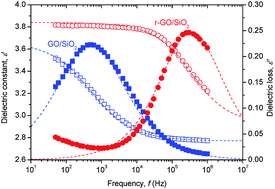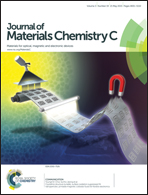Graphene oxide vs. reduced graphene oxide as core substrate for core/shell-structured dielectric nanoplates with different electro-responsive characteristics†
Abstract
Not only the polarizability but also the polarization rate of particles is important to the electro-responsive electrorheological (ER) characteristic of particle suspensions. In this paper, we respectively used non-conducting graphene oxide (GO) and conducting reduced graphene oxide (r-GO) as the core and use insulating SiO2 as the shell to prepare core/shell-structured dielectric nanoplates for the purpose of achieving an optimum ER response to different electric stimuli. The morphology and structure of the samples are characterized by scanning electron microscopy, transmission electron microscopy, atomic force microscopy, X-ray diffraction, thermogravimetric analysis, Raman spectroscopy, and X-ray photoelectronic spectroscopy. The conductivity and dielectric properties are measured by an impedance analyzer and the electro-responsive ER characteristics of nanoplates dispersed in insulating oil are investigated by a rheometer. These demonstrate that coating with SiO2 can provide an electrical insulating effect for the GO or r-GO core, while GO vs. r-GO as the core can induce distinctly different dielectric polarization responses. Compared to GO/SiO2, r-GO/SiO2 shows a significantly faster polarization rate due to the high conductivity of the r-GO core. As a result, the r-GO/SiO2 suspension exhibits a high ER response to high-frequency AC electric fields, while the GO/SiO2 suspension exhibits a high ER response to DC or low-frequency AC electric fields. This different electro-responsive characteristic can be explained by the influence of the polarization rate on interparticle interaction.


 Please wait while we load your content...
Please wait while we load your content...